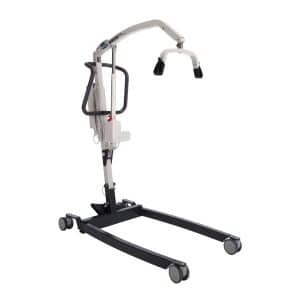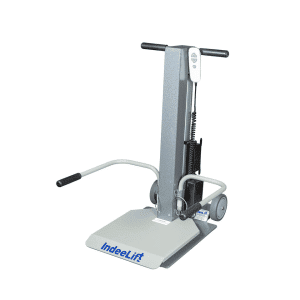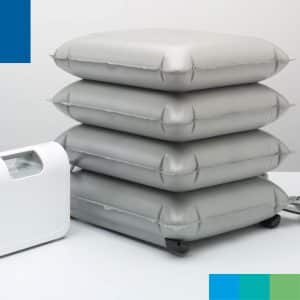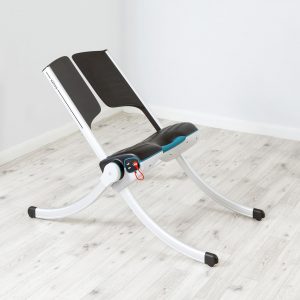The Best Falls Lifting Equipment for Care Homes in 2024; An Honest Comparison
It’s estimated that 1,000 care home residents in the UK fall every day1, and despite the majority of fallers suffering minor or no injuries, care homes often default to calling the ambulance service to lift the fallen resident due to a lack of appropriate lifting equipment in the care home.
With the ever-growing pressure on the ambulance service and the NHS, it’s more important than ever for care homes to manage minor and no-injury falls that occur in their own home, without having to call the ambulance service.
In this article, we will cover off the best falls lifting equipment available on the market today, and explain the benefits and drawbacks of each. To be upfront, we supply the Raizer lifting chair here at Felgains, but we know that as buyers we want to be able to see all the options and alternatives, so we will aim to show you an unbiased view of all of the options that are out there, in no particular order.

Best falls lifting equipment options
Mobile Hoists

Mobile hoists have been a standard piece of equipment in care homes for many years, and whilst they are excellent for a lot of patient handling tasks, that are a number of drawbacks to hoists when using them for lifting fallen residents.
Benefits of Mobile Hoists
- Cost and training. Your care home is likely to already own a hoist, so the extra cost and training of staff is minimal.
- Suitable for particularly frail residents. Because you can use a hoist to transfer someone in a sling from the floor directly to a bed or chair, a hoist can be used for very frail or non-ambulant residents that are unable to mobilise from a lifting chair or cushion.
Drawbacks of Mobile Hoists
- Portability. Compared to the other options in this article, hoists are the largest and bulkiest. If a resident has fallen in an enclosed place such as a bathroom, which is very common, you will struggle to lift them using a hoist due to the amount of space needed to use it.
- Lack of dignity. For residents, and particularly those with dementia, being lifted in a hoist can be very distressing due to the ‘hands-on’ and enclosed nature of the sling.
IndeeLift Human Floor Lift

The IndeeLift Human floor lift is designed to lift people from the floor to a normal chair height, allowing them to stand or transfer with the least amount of effort.
Benefits of the IndeeLift Human Floor Lift
- Small footprint. The small footprint of the Indeelift Human Floor Lift means it can be used in small places where a traditional hoist could not be used, such as a bathroom.
- Lifts the fallen person to a seated position, which makes transferring to a wheelchair or chair simple.
Drawbacks of the IndeeLift Human Floor Lift
- Ease of implementation and training. The IndeeLift is an American product and is not common in the UK, so carers are unlikely to have seen or used the product before, which could lead to training difficulties if implemented in your care home.
- Weight. Compared to the other options on the market, the IndeeLift is reasonably bulky and weighs over 30kg, which could present some issues with portability, especially if your care home has stairs or steps.
- Dignity and comfort. The design of the IndeeLift, and the hard metal scoop, make it a less comfortable and potentially less dignified option for lifting residents.
- The resident has to be seated on the floor, in order to use the IndeeLift to lift them.
Mangar Inflatable Lifting Cushions

The Mangar Lifting Cushions are a range of air-powered emergency lifting cushions that are designed to be put under a fallen resident and inflated to lift the fallen person off the floor.
There are currently three models of the Mangar Lifting Cushion:
- The Elk. The Elk is the smallest cushion and doesn’t have a backrest, making it portable and popular with ambulance crews. Safe working load: 450kg
- The Eagle. Larger than the Elk, but smaller than the Camel, the Eagle is the latest cushion from Mangar and incorporates a backrest to help support the back, neck, and head of the fallen person. Safe working load: 220kg
- The Camel. The largest and widest cushion in the Mangar range, and with a backrest, the Camel is particularly suitable for larger and heavier residents. Safe working load: 320kg
Benefits of the Mangar Cushions
- Portability. This is particularly true with the Mangar Elk, which weighs just 3.6 kg and folds up for easy carrying.
- Versatility. With high safe working loads, the Mangar cushions are suitable for lifting bariatric residents.
- Cost. Cost-wise, the Mangar cushions are economical and are one of the cheaper options on the market.
Drawbacks of the Mangar Cushions
-
- You have to transfer the fallen person onto the cushion, which requires much more space and effort from the caregivers, and involves a lot of hands-on pushing and pulling on the faller.
- Instability. The Mangar cushions rely on air to lift the fallen person, which means that when the cushion is inflating it is quite unstable for the service user and assistance is required from a carer. However, when the Mangar cushions are fully inflated, they are solid and stable.
- Noise. The noise of the Mangar compressor can be distressing for some residents, particularly those with dementia.
- Battery life. The Mangar compressor’s battery lasts for 3-4 lifts, which can sometimes leave you unable to lift a fallen resident due to a flat battery.
Raizer Lifting Chair

The Raizer is a motorised lifting chair that is assembled around a fallen person to lift them up from the floor after they have had a minor or no-injury fall.
Benefits of the Raizer
- The Raizer assembles around the fallen person, so you don’t have to physically get someone onto it or move them around hardly at all.
- Stability. The four lifting arms keep the Raizer stable as it lifts, giving assurance to the fallen resident and caregiver.
- Reliability. The Raizer can complete 80 lifts on one battery charge and it can be left on charge, so you will never be in a situation where a resident has fallen and you are unable to lift them due to the battery being flat.
- Speed. Ease of assembly and speed of operation allows a fast response – typical operation including assembly is about 3 minutes.
- Ease of use and training. Minimal physical effort is required to operate the Raizer, so there is significantly less risk of injury to carers. Because it is impossible to assemble incorrectly, carers find it very intuitive to use.
- Can lift the resident to a perching position, making standing or transferring easier for the resident and caregiver.
Drawbacks of the Raizer
We have a complete article covering all of the drawbacks of the Raizer. The main drawbacks of the Raizer are:
- Weight of the Raizer seat unit. The seat unit weighs 8kg, which can be heavy if carried for long periods of time without a Raizer trolley.
- Safe working load. With a safe working load of 150kg, the Raizer isn’t suitable for bariatric residents.
- Cost. Compared to the alternatives above, the Raizer chair comes with the highest price tag. We have an article outlining exactly how much the Raizer costs, and what affects the price.
Which option is right for you?
We’ve tried to do our best to set out the benefits and drawbacks of each falls lifting equipment option, but ultimately, the piece of equipment you choose for your care home is a choice that may differ depending on your requirements. For example, if your care home is one that experiences falls frequently, you will need a piece of equipment that is portable, reliable, and easy for staff to use.
If you would like to talk the options through with us, or book a trial of a falls lifting product for your care home, feel free to contact us on the form below and we will be happy to talk.
Citations
[1] Cardiff University, 2006
Get in touch
Got a question or want to send us a message? Let’s talk.

